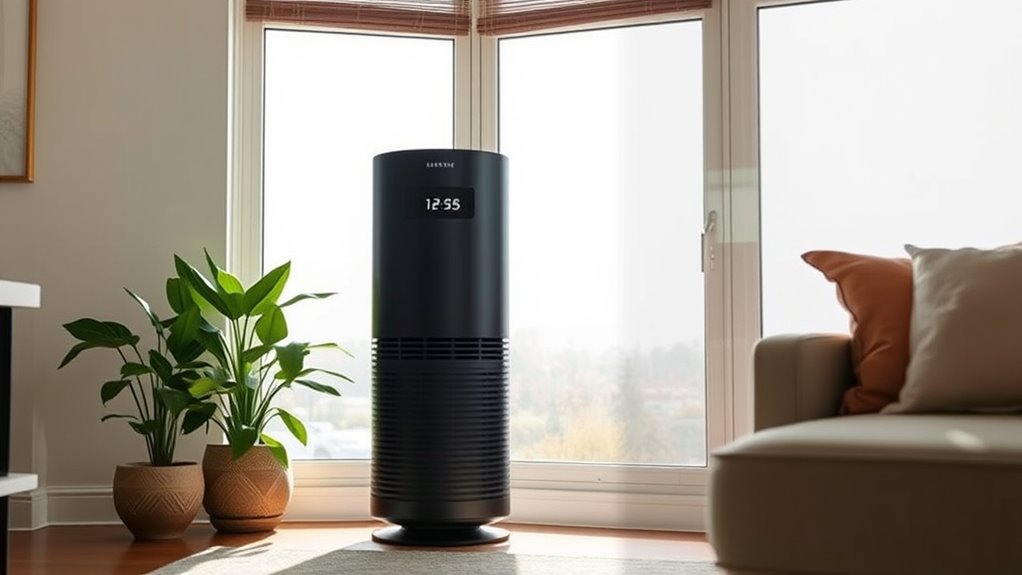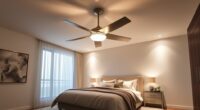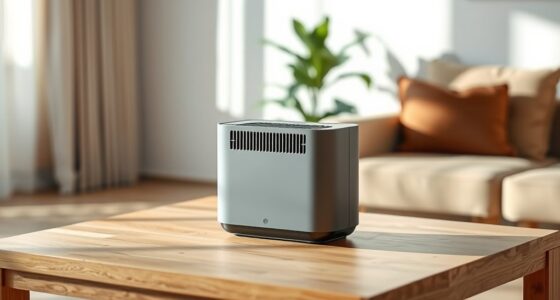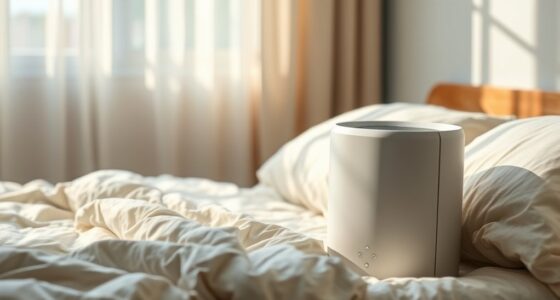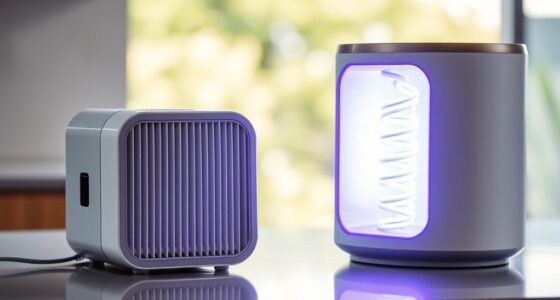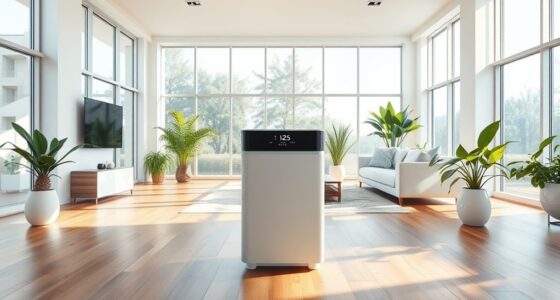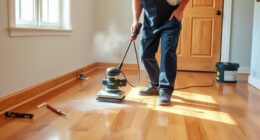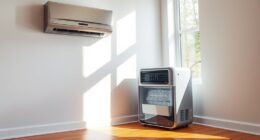When choosing an air purifier for wildfire smoke, look for models with HEPA filters that trap at least 99.97% of particles as small as 0.3 microns, including smoke, allergens, and pollutants. confirm it has a high CADR to match your room size and includes activated carbon filters for odor and VOC removal. Consider smart features like air quality sensors for automatic adjustments and easy maintenance options. If you keep exploring, you’ll find ways to select the best fit for your space and needs.
Key Takeaways
- Choose models with HEPA filters that capture ≥99.97% of particles as small as 0.3 microns for effective wildfire smoke removal.
- Match the purifier’s CADR to your room size to ensure efficient smoke and pollutant clearance.
- Look for activated carbon filters to adsorb odors and harmful gases associated with wildfire smoke.
- Prioritize units with easy-to-replace filters and regular maintenance to maintain optimal performance.
- Opt for smart purifiers with air quality sensors and adjustable settings for automatic, efficient operation.
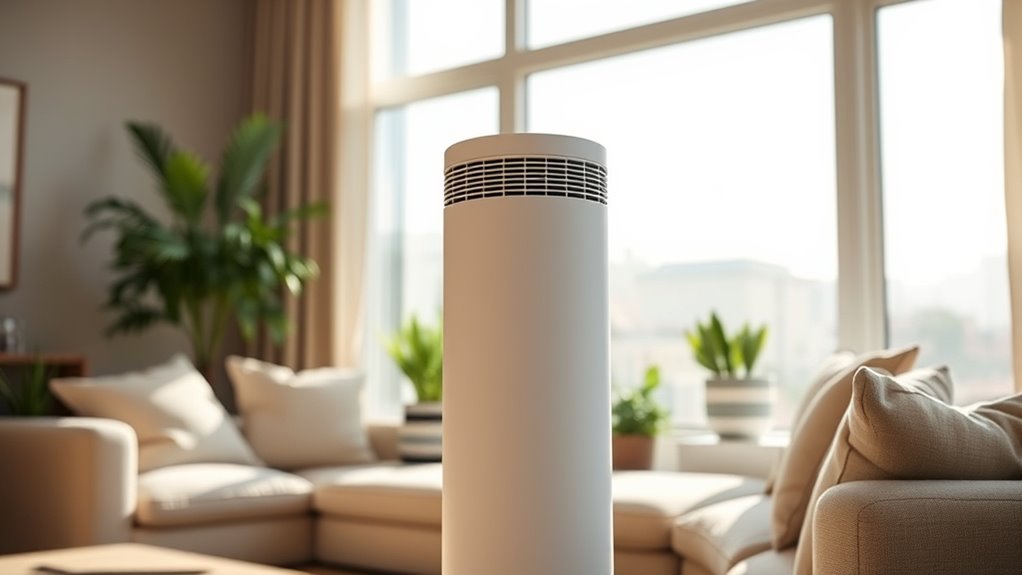
When wildfire smoke fills the air, air purifiers become vital tools for protecting your indoor environment. The primary goal is to improve air quality, which can be severely compromised during wildfire events. To do this effectively, you need an air purifier that offers high filtration efficiency. Filtration efficiency refers to how well the device can remove tiny particles, including the hazardous particles found in wildfire smoke. Look for models equipped with HEPA filters, as these are designed to capture at least 99.97% of particles as small as 0.3 microns, including smoke particles, allergens, and other pollutants. The higher the filtration efficiency, the cleaner and safer your indoor air becomes.
Beyond the filter type, consider the purifier’s CADR (Clean Air Delivery Rate) rating. CADR measures how quickly an air purifier can clean the air in a specific size room, so choosing a unit with a high CADR guarantees your space is effectively cleared of smoke particles. It’s important to match the CADR to the size of the room you want to purify; a small purifier in a large space won’t do the job. Also, pay attention to the device’s capacity—some purifiers are designed for small rooms, while others can handle entire homes or large open spaces. An appropriately sized unit will provide better air quality and filtration efficiency.
Another essential factor is the purifier’s ability to handle odors and volatile organic compounds (VOCs) often present during wildfires. Look for models with activated carbon filters, which adsorb smoke odors and harmful gases. This addition helps improve overall indoor air quality and makes your environment more comfortable during smoky conditions. When selecting an air purifier, also consider ease of maintenance and filter replacement. Regularly changing filters ensures the device continues to operate at peak filtration efficiency, maintaining high air quality.
Lastly, choose a purifier with smart features or adjustable settings so you can monitor air quality levels and customize operation based on real-time needs. Some models come with air quality sensors that automatically adjust fan speeds, optimizing filtration efficiency without wasting energy. Investing in a reliable, well-rated air purifier with proven filtration efficiency and proper capacity guarantees that you’re actively reducing smoke particles, allergens, and odors. This way, you create a healthier indoor environment even when wildfire smoke is thick outside. With the right purifier, you safeguard your air quality, breathing easier and maintaining peace of mind during wildfire seasons.
Frequently Asked Questions
How Often Should I Replace the Filters During Wildfire Season?
You should check your air purifier’s filter lifespan and follow its recommended replacement schedule, especially during wildfire season. Typically, filters need replacing every 3 to 6 months, but smoke and pollutants can shorten this time. Keep an eye on filter indicators or signs of reduced airflow. Regularly replacing filters guarantees your purifier works effectively, keeping your indoor air cleaner and safer during smoky conditions.
Are There Specific Air Purifier Brands Recommended for Wildfire Smoke?
Wildfire smoke challenges your air quality, so choosing the right purifier matters. While many brands promise clean air, focus on those with a strong reputation for quality and reliable filter technology. Brands like IQAir, Blueair, and Austin Air stand out for their effective filtration and durability. Don’t just pick a popular name; confirm the purifier’s filters are designed specifically to tackle wildfire smoke, giving you peace of mind during smoky seasons.
Can Air Purifiers Eliminate All Types of Wildfire Pollutants?
You might wonder if air purifiers can eliminate all wildfire pollutants. While they’re effective at capturing many particles, filter limitations mean some pollutants, like gases and volatile organic compounds, can slip through. Wildfire smoke contains diverse pollutants, so no single purifier can remove every type completely. To maximize protection, choose a purifier with a high-efficiency HEPA filter and activated carbon. Remember, proper ventilation and source control are also essential.
What Maintenance Is Required to Keep Purifiers Effective Against Smoke?
Ever wonder how to keep your air purifier working effectively against smoke? Regular maintenance is key. You should check the filter lifespan often and replace filters as recommended by the manufacturer. Also, clean the pre-filters and exterior regularly to prevent dust buildup. Isn’t it worth spending a few minutes on filter cleaning and timely replacements to guarantee your purifier continues to protect your indoor air from harmful wildfire pollutants?
Do Portable Air Purifiers Suffice for Large or Multi-Room Areas?
Portable air purifiers can work for small spaces, but their portable coverage often limits multi-room effectiveness. If you’re trying to clean larger or multiple rooms, you might need a more powerful, whole-house system. Relying solely on a small purifier may leave some areas less protected. For all-encompassing wildfire smoke protection, consider options that provide better multi-room effectiveness or multiple units placed strategically around your home.
Conclusion
When choosing an air purifier for wildfire smoke, think of it as your shield in a storm—standing strong against harmful particles. Look for models with high CADR ratings and HEPA filters to clear the air effectively. With the right purifier, you’ll breathe easier, like a clear sky after a storm passes. Don’t wait for smoke to settle—equip yourself now and turn your home into a safe haven that stands resilient amidst the chaos.
